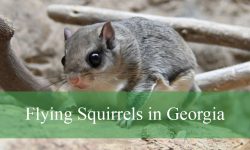You might be someone who has come across different types of black and yellow caterpillars for the first time. Identifying these crawling insects can help differentiate between the poisonous and non-poisonous species.
Examples of yellow and black caterpillars are the monarch, white-marked tussock, yellow-spotted tussock, six-spot burnet, catalpa sphinx, and giant sphinx. These crawling creatures have to turn into beautiful winged insects.
This identification guide provides descriptions and pictures of various black and yellow caterpillar species. The information will also help us know what caterpillar species turn into a moth or butterflies after pupation.
Are Black and Yellow Caterpillars Poisonous?
Most black and yellow caterpillars are non-aggressive and non-poisonous. But refrain from touching the furry black and yellow caterpillars since the barbed spines can cause skin irritation and pain.
Other examples of poisonous black and yellow caterpillars are monarch and cinnabar moth caterpillars. The venom in the spines can kill small birds and rodents when eaten in large quantities.
Some species with horns, fuzzy bodies, eye-like markings, and vibrant colors may appear menacing. But these caterpillars use the features to ward off potential predators for self-defense.
Do not worry when you notice yellow and black caterpillars infesting your backyard or garden. Use chemical treatments to eliminate them and prevent crop destruction in your garden.
Different Types of Black and Yellow Caterpillars
Identifying different types of leaf-eating caterpillars in your garden or yard can be a daunting experience. Here is a list of black and yellow caterpillars for easy identification:
Erasmia Pulchella Moth Caterpillar
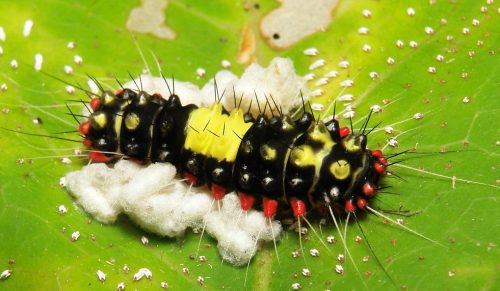
It is a sizable black caterpillar with a conspicuous yellow segment at the center. The row of bright red dots with white spiky hairs along the body is ideal for identification.
The Erasmia Puchalla moth caterpillar belongs to the venomous species and can kill any animal after ingestion. Refrain from touching the caterpillar to avoid skin irritation.
These grubs are native to Southern and Eastern Asia. They love feeding on the leaves of tropical plants in the garden and turn into multi-colored moths after pupation.
Identification Features |
Bright red dots line with white spiky hairs
Black body with a prevalent yellow segment at the center. |
Host Plants |
Tropical plants |
Scientific Name |
Erasima Puchella |
Red Admiral Butterfly Caterpillar
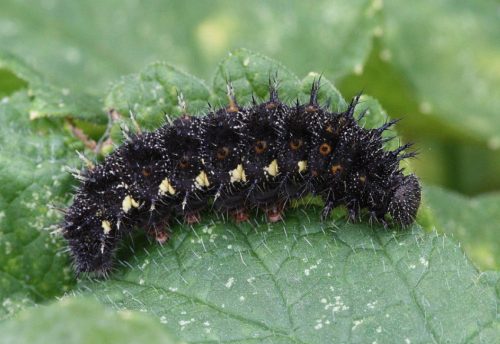
It is a black butterfly caterpillar with prominent yellow patches along the sides. The grub also has white speckles around the body with short wispy spines.
These caterpillars usually form a tent under the leaves or in the bark and only come out to eat. They love living on the stinging nettle plants.
Red admiral butterfly caterpillars turn into beautiful butterflies with black wings, red bands, and white spots after pupation. The butterfly symbolizes a powerful spirit or soul.
Identification Features |
Spiky black caterpillar with distinctive yellow patches. |
Host Plants |
Stinging nettle plant |
Scientific Name |
Vanessa atalanta |
Virginia Ctenucha Caterpillar
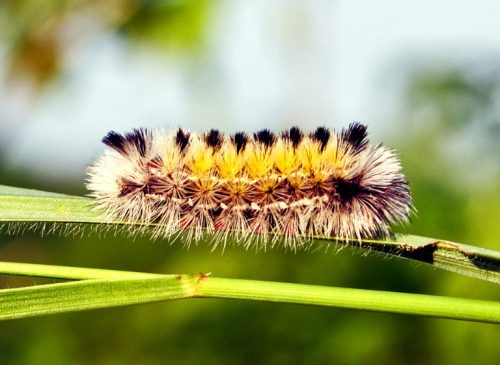
It is a fuzzy black and yellow caterpillar with tufts of hair around its body. Some caterpillar species may appear black with white bands along their sides and yellow hairs.
These furry caterpillars also have a deep red globular head and red prolegs for easy identification. They are native to North America and can grow up to an inch long.
Virginia Ctenucha caterpillars feed on ornamental grasses, sedges, and irises. They turn into black moths with vibrant metallic blue-green bodies and bright orange heads.
Identification Features |
Small caterpillar covered in black, white, and yellow hairs |
Host Plants |
Ornamental grasses, sedges, and irises |
Scientific Name |
Ctenucha virginica |
Neighbor Moth Caterpillar
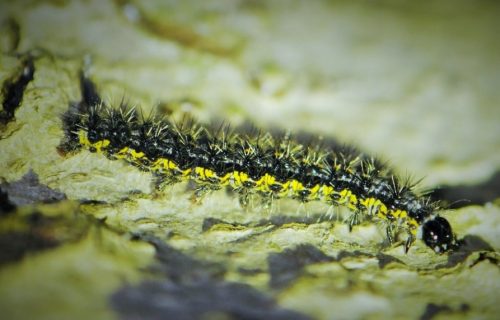
It is a sizable black caterpillar with a striking yellow band along each side and white lines on its back. The grub also has tufts of black hair and fleshy spines scattered on its body.
The slug-like caterpillar hails from the United States of America and loves feeding on leaves of oak, hazelnuts, and other native deciduous trees.
Neighbor moth caterpillars turn into beautiful moths after pupation. These large creamy moths have dark brown markings on their wings.
Identification Features |
Spiky black caterpillar with striking yellow bands along its body and white thin lines on its back. |
Host Plants |
Oak, hazelnuts, and deciduous trees |
Scientific Name |
Haploa contigua |
Toadflax Moth Caterpillar
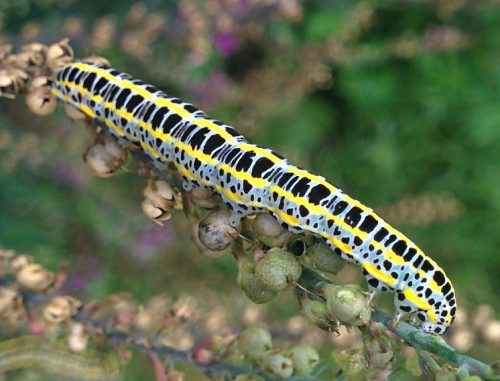
It is a black caterpillar with bright yellow stripes and white dots along its body. The crawling insect usually develops black, pale green, and yellow markings at maturity.
Toadflax moth caterpillars are voracious and can defoliate toadflax plants. The patterns on these caterpillars keep changing colors throughout the instars.
The caterpillar turns into a gray moth with dark and light markings on the wings after pupation. Refrain from touching the larva to avoid skin irritation and burning sensation.
Identification Features |
Bluish-gray caterpillar with jet-black markings and yellow stripes. |
Host Plants |
Toadflax plants |
Scientific Name |
Calophasia lunula |
Magpie Moth Caterpillar
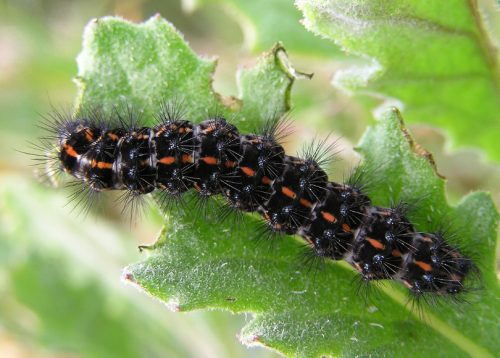
It is a pale-yellow caterpillar with black spots along its body and an orange stripe at the abdomen base. This crawling insect is also covered in short fine black hairs.
The looping movement over plant leaves and stems is the distinctive trait for easy recognition. These caterpillars feed on the leaves of gooseberry and blackthorns.
These grubs turn into magpie moths after pupation in July to September. Use chemical treatments to eliminate excess caterpillars from your plants.
Identification Features |
Creamy yellow body caterpillar with black spots. |
Host Plants |
Hawthorn, blackthorn, gooseberry, and Japanese spindle |
Scientific Name |
Abraxas grossulariata |
Buff-Tip Moth Caterpillar
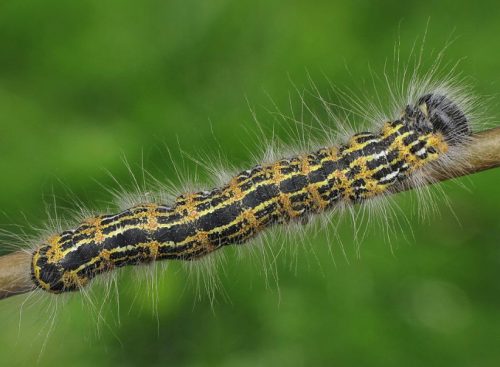
It is a soft-bodied caterpillar with yellow stripes along its body and orange patches on each segment. The tufts of pale setae and black globular heads are distinctive features.
The slender tube-shaped caterpillar has V markings on the black globular head. These grubs love feeding on oak, beech, willow, and hazel trees.
The yellow spines can cause skin irritation and a burning sensation upon touching. We recommend not touching without protective gear.
Identification Features |
Contrasting black, yellow, and orange patterns. |
Host Plants |
Willow, hazel, oak, and beech |
Scientific Name |
Phalera bucephala |
Cabbage White Caterpillar
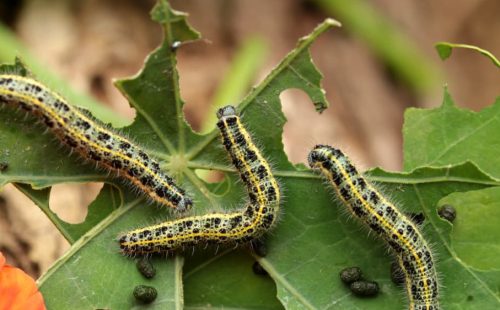
It is a yellow caterpillar with fine setae and sizable black dots on its body. The slug-like caterpillar keeps changing colors throughout different growth stages.
These furry yellow caterpillars feed on cabbages, kales, turnips, cauliflower, swede, Brussels sprouts, and kohlrabis. They turn into cabbage-white butterflies after pupation.
Identification Features |
Fuzzy yellow caterpillar covered in black spots, white hairs, and black tubercles. |
Host Plants |
Cabbages, cauliflowers, and kohlrabis |
Scientific Name |
Pieris brassicae |
Grass Eggar Moth Caterpillar
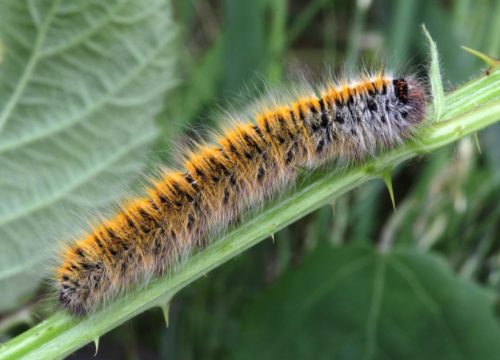
The fuzzy black caterpillar has fine yellowish-orange hairs and a round head with faint orange markings. The grub may appear orange and black, depending on the species.
These hairy yellow caterpillars are more active in late March and April. They feed on deciduous trees, ornamental grasses, and shrubs.
The grass eggar caterpillars turn into attractive fuzzy brown moths after pupation. These moths are active at night in August and September.
Identification Features |
Black caterpillar with yellowish-orange hairs |
Host Plants |
Peas, beans, and ornamental trees or shrubs. |
Scientific Name |
Lasiocampa trifolii |
White-lined Sphinx Moth Caterpillar
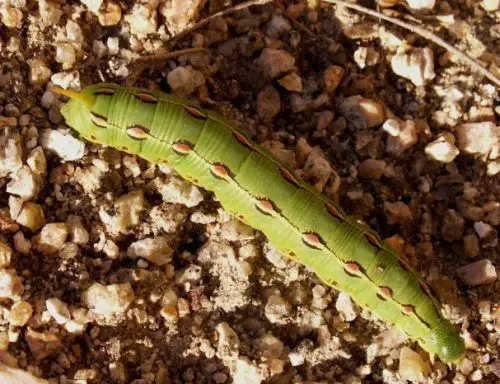
It is a greenish-yellow caterpillar with black stripes along its abdomen. The slug-like creature has small triangular black markings and brownish spots on the sides.
The several color variations make it challenging to identify white-lined sphinx moth caterpillars. Some have a dark green body with black and white dots or lime green.
The white-lined sphinx moth caterpillar’s color variations are due to climate change. They love feeding on tomatoes, elms, apples, grapes, and evening primrose.
Identification Features |
Greenish-yellow worm-like body with black stripes and brownish-black markings along the sides and back. |
Host Plants |
Apples, elms. Grapes, and tomatoes |
Scientific Name |
Hyles lineata |
Lily Borer Caterpillar
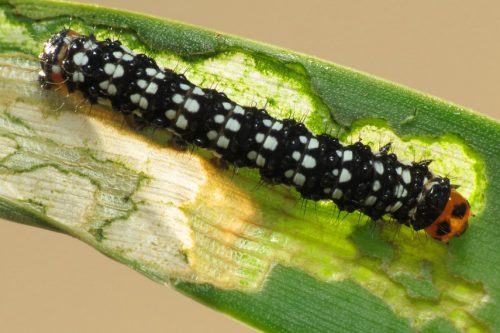
The bright yellow caterpillar has dark to black bands around each segment with pale brown or orange head and red dots on each black band.
These yellow grubs later develop orange spots to give them a mottled black-and-yellow appearance. They love dwelling in lily and amaryllis plants.
Lily borer caterpillars turn into white moths in summer after pupation. Spray the caterpillars with insecticides to prevent the defoliation of your flowering perennials.
Identification Features |
Dark bands around the yellow segments |
Host Plants |
Lily and amaryllis plants |
Scientific Name |
Diaphone eumela |
Catalpa Sphinx Caterpillar
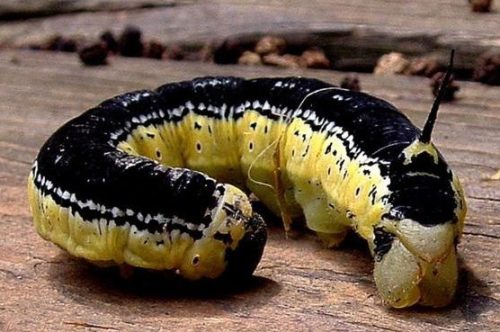
It is a shiny jet-black caterpillar with yellow markings along its sides. These yellow dots join to form lines on each side at maturity.
Catalpa sphinx caterpillars are also called Catawba worms and can grow up to two inches long. These caterpillars have a black head and tapered tail end.
These grubs feed on the foliage of catalpa trees or cigar trees and are native to Texas, Florida, Maine, and Lowa. The caterpillars turn into large brown moths after pupation.
Identification Features |
Black body caterpillar with yellow and black markings |
Host Plants |
Catalpa trees |
Scientific Name |
Ceratomia catalpae |
Amaryllis Borer Caterpillar
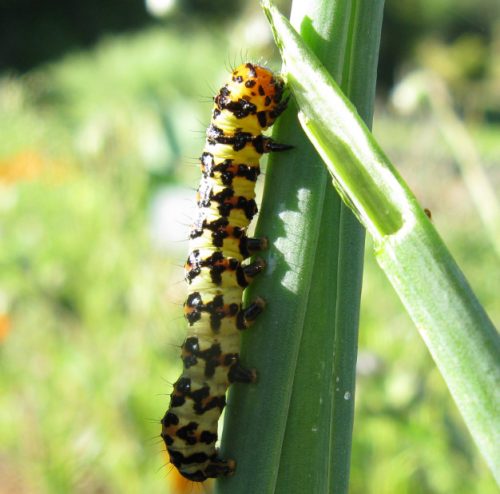
It is a chunky black caterpillar with oval-shaped dull yellow spots forming between the segments. It also has a round rusty brown head and fine setae around its body.
The caterpillar species is related to the lily borer counterpart and can damage your plants. They feed on the lily stems and leaves in early spring through summer.
Amaryllis borer caterpillars are poisonous to birds and small rodents after ingestion in large quantities. Avoid touching these caterpillars to prevent skin irritation.
Identification Features |
Black body and pale-yellow bands around each segment. |
Host Plants |
Crinum, Clivia, and Hippeastrum species |
Scientific Name |
Brithys crini |
Police Car Moth Caterpillar
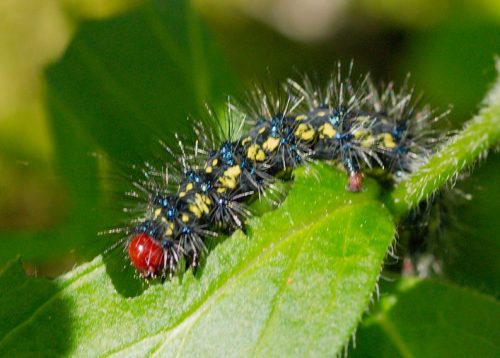
It is a spiky black caterpillar with bright yellow markings along the fuzzy body. The broken yellow bands and tufts of the spine are distinctive features for identification.
The round reddish head and iridescent blue spots give police car moth caterpillars an unusual appearance. These caterpillars are also called green lattice moth larvae.
The green lattice moth caterpillars love feeding on the nectar of herbaceous flowers before turning into spectacular moths in summer.
Identification Features |
Glossy-jet black spiky body with yellow and metallic blue spots and reddish head. |
Host Plants |
Mertensia, Lithospermum, and Hackelia species |
Scientific Name |
Gnophaela vermiculata |
Scarlet Tiger Moth Caterpillar
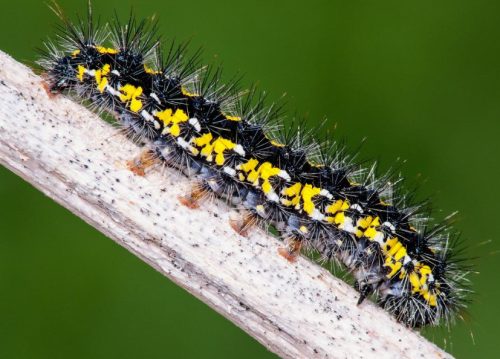
It is a spiky black caterpillar with broken white-yellow bands along its abdomen. The tufts of black spines occur on each segment to give a menacing appearance.
Scarlet tiger moth caterpillars feed on stinging nettle and common comfrey. They emerge from the cocoons in early spring and overwinter in the ground.
These caterpillars turn into black and red moths marked with yellow, red, and white dots on the back of the forewings.
Identification Features |
Black caterpillar with yellow stripes, white spots, and tufts of black forewings. |
Host Plants |
Stinging nettle plants |
Scientific Name |
Callimorpha dominula |
Alder Moth Caterpillar
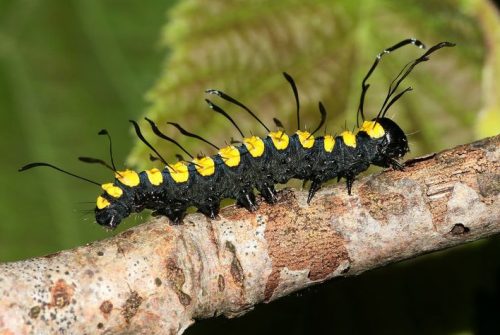
It is a black and yellow caterpillar with conspicuous yellow stripes across the back. It also has several black spikes and two pairs of antennae-like projections.
These caterpillars love feeding on the leaves of alders and birches from spring through early fall. Juvenile counterparts resemble bird droppings from a distance.
These striped caterpillars turn into alder moths after pupation. The moths have brown forewings with creamy mottled patterns and lighter rear wings.
Identification Features |
Yellow bands on a glossy black cylindrical body with paddle-like spikes on the sides. |
Host Plants |
Alder and birches |
Scientific Name |
Acronicta alni |
Fall Webworm Caterpillar
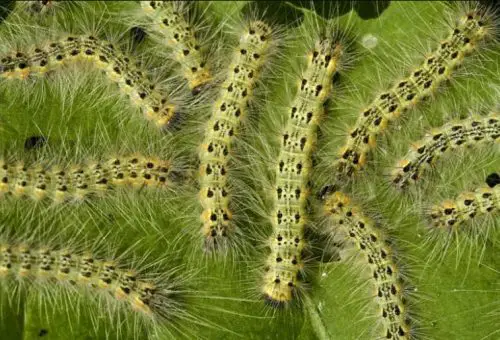
It is a fuzzy caterpillar with a bristly body, black spots, and yellow spines. Each segment has some black dots and tufts of yellow bristles.
The hairy yellow caterpillar creates tent-like structures on hardwood tree branches in late summer and fall. They feed on walnut, crabapple, and cherry.
Identification Features |
Fuzzy yellow caterpillar with a bristly body, black dots, and yellow spines. |
Host Plants |
Walnut, cherry, and crabapple |
Scientific Name |
Hyphantria cunea |
American Dagger Caterpillar
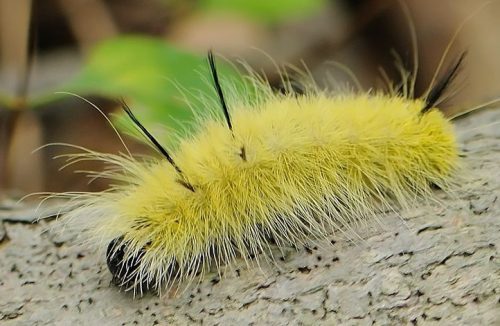
It is a caterpillar with yellow hairs and two pairs of black hair-like spines on its back and tail. The glossy black head is the distinctive feature for identifying this yellow grub.
The American dagger moth caterpillar feeds on the leaves of birch, maple, oak, and willow trees. This furry yellow caterpillar turns into a brown moth after pupation.
Identification Features |
Yellow caterpillar with long feathery hairs on its body. |
Host Plants |
Hickory, birch, maple, and oak |
Scientific Name |
Acronicta americana |
White Flannel Moth Caterpillar
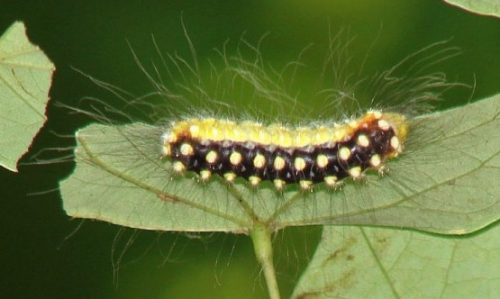
It is a black fuzzy venomous caterpillar with bright yellow dots on each segment and a yellow underside. The stinging caterpillar also has tufts of feathery spines on its body.
Avoid touching the caterpillar to prevent getting stung and experiencing skin irritations or burning sensations. The caterpillar turns into a beautiful white hairy moth.
Identification Features |
Black body covered in tufts of stinging spines with yellow spots |
Host Plants |
Black locust, elm, greenbrier, and hackberry |
Scientific Name |
Norape ovina |
Smeared Dagger Moth Caterpillar
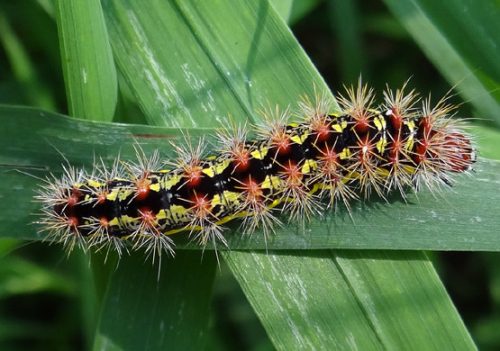
It is a black body caterpillar with tufts of spines and white markings on its back. The yellow longitudinal bands are distinctive features for easy identification.
The jagged-looking tufts of white or reddish-brown spines are ideal for defense. The smeared dagger moth caterpillar belongs to the venomous species.
These caterpillars feed on strawberry plants, oaks, willows, and other deciduous shrubs or trees. Refrain from touching the caterpillars since they give nasty stings.
Identification Features |
Bristly black body with longitudinal yellow bands and white markings on the back. |
Host Plants |
Strawberry plants, oaks, and willows |
Scientific Name |
Acronicta oblinita |
Mullein Moth Caterpillar
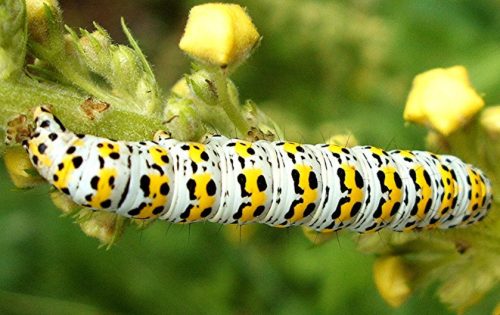
It is a white or pale green body caterpillar with yellow circles and black dots. The bright colors make this fat grub eye-catching and vulnerable to predation.
These caterpillars love feeding on the leaves of Mullein, buddleia, and figworts from July through August. They are harmless though the hairs can cause skin irritation.
Identification Features |
Yellow, black, and white colors |
Host Plants |
Buddleia, Figworts and Mullein |
Scientific Name |
Cucullia verbasci |
Red-Humped Caterpillar
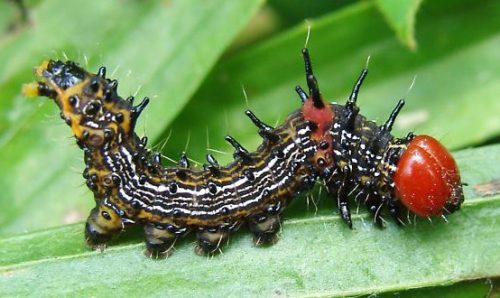
It is a moth caterpillar with a bright yellow body marked by black and white bands. It is also called a striped yellow caterpillar with a conspicuous red hump.
These caterpillars love feeding on the leaves of cottonwood, walnut, and willow trees in colonies. The black fleshy tentacles are also distinctive features for easy recognition.
Identification Features |
Yellow and black stripes with red hump and redhead. |
Host Plants |
Cottonwood, willow trees, and walnut trees |
Scientific Name |
Schizura concinna |
Yellow-Necked Caterpillar

It is a black caterpillar with yellow stripes along the body lengthwise. The hairy caterpillar also has white feathery spines and a black head.
The yellow-necked caterpillar usually rolls its body when feels threatened to create a distinctive U shape. They turn into spectacular moths after pupation.
Identification Features |
Longitudinal yellow stripes on a black furry body with yellow and black feet. |
Host Plants |
Honey locust, oak, maple, elm, and birch |
Scientific Name |
Datana ministra |
Black Swallowtail Caterpillar
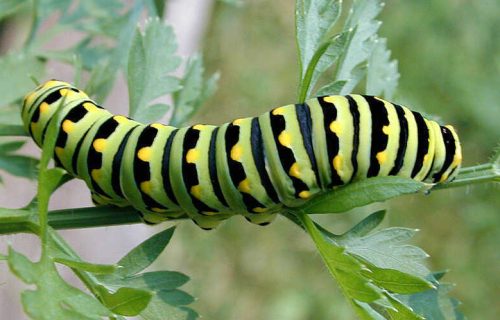
It is a type of green caterpillar with black and yellow markings. The black bands traverse the caterpillar segments with yellow dots.
The black swallowtail caterpillar also has white or green prolegs with black and yellow markings. These caterpillars turn into beautiful butterflies after pupation.
Identification Features |
Black bands and yellow dots on the bright green body. |
Host Plants |
Carrots, celery, parsley, and parsnip |
Scientific Name |
Papilio polyxenes |
Grapeleaf Skeletonizer Caterpillar
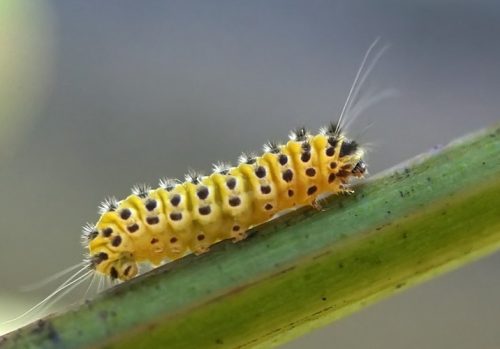
It is a stout yellow caterpillar with yellow bands and a row of black dots for easy identification. These caterpillars love feeding on grapevine leaves in colonies.
These grape leaf skeletonizer caterpillars are non-poisonous though the irritating hairs can give nasty rashes. They turn into black moths with orange thoraces and two wings.
Identification Features |
Bands of black dots |
Host Plants |
Wild grapes and grapevines |
Scientific Name |
Harrisina americana |
Giant Sphinx Caterpillar
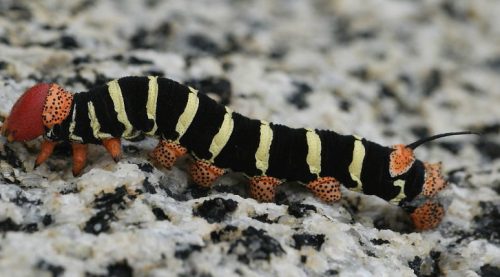
It is a sizeable black caterpillar with yellowish-green bands around its segment. The orange prolegs, tail, and head are distinctive features for easy recognition.
The giant sphinx caterpillar is poisonous and can kill small birds or rodents if ingested in large quantities. Stinging hairs can cause skin irritation and nasty rashes.
Identification Features |
Jet-black body with yellow bands and orange head and tail |
Host Plants |
Plumeria and Allamanda species |
Scientific Name |
Pseudosphinx tetrio |
Common Sheep Moth Caterpillar
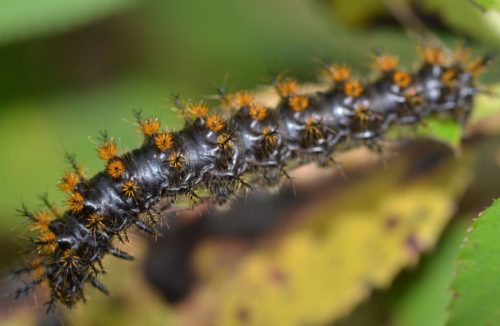
The brownish-black body caterpillar has a menacing appearance due to the tufts of black spiky and yellow or orange spines.
These caterpillars love feeding on the leaves of bitter cherry, bitterbrush, wild roses, and mountain-mahogany plants.
Identification Features |
Orange tufts on the back |
Host Plants |
Mountain lilac, mountain mahogany, bitter cherry, bitterbrush, snowberry, wild rose, willow |
Scientific Name |
Hemileuca eglanterina |
Brown-Hooded Owlet Caterpillar
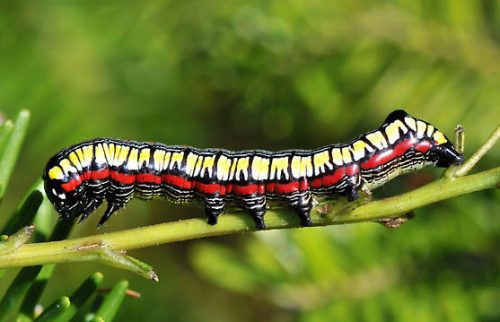
It is a colorful caterpillar with shiny black bands and yellow markings. The white markings are less conspicuous, while the horizontal line runs above the black legs.
The brown-hooded owlet caterpillar is also called the calico paint caterpillar due to its shiny black head and yellow markings. It can grow up to an inch long.
Identification Features |
Horizontal yellow and black markings along the body. |
Host Plants |
Solidago rugosa |
Scientific Name |
Cucullia convexipennis |
Black and Yellow Zebra Caterpillar
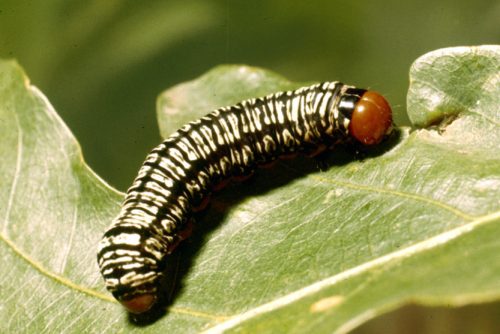
It is an unusual caterpillar type with prominent black and yellow stripes running along the body lengthwise. The thin black stripes on each segment resemble a zebra.
The black and yellow zebra caterpillar has a reddish-brown underside and can grow up to 1.6 inches long. It turns into an American noctuid moth after pupation.
Identification Features |
Broad creamy-yellow stripes and black stripes along its body lengthwise. |
Host Plants |
Beets and cabbages |
Scientific Name |
Melanchra picta |
Yellow and Black Cinnabar Caterpillar
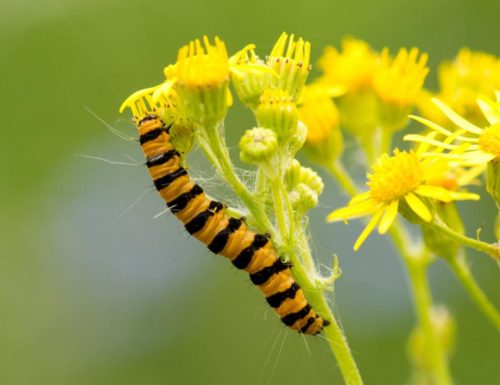
It is a beautiful worm-like caterpillar with jet-black bands around its segments. It also has black hair-like or white spines sparsely on its body.
The bright yellow and black colors imply that this caterpillar species can be poisonous to birds or small rodents when eaten. They turn into black moths after pupation.
Identification Features |
Jet-black body with yellow stripes |
Host Plants |
Ragwort |
Scientific Name |
Tyria jacobaeae |
Queen Caterpillar
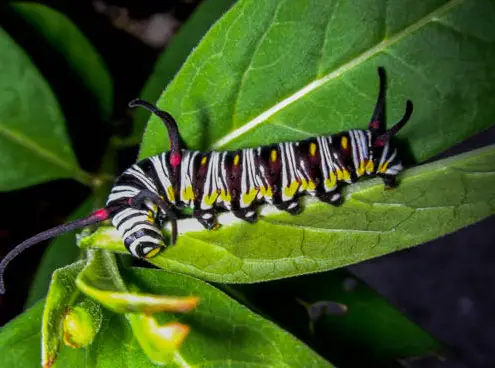
It is a sizeable black caterpillar with yellow dots, white stripes, and black tentacles. It relates to a monarch caterpillar though it has a black head with white rings.
The queen caterpillar’s stripes can be yellow, blue, green, or brown. This spectacular caterpillar turns into a red butterfly after pupation.
Identification Features |
Black body with white transverse bands |
Host Plants |
Milkweeds and butterfly weed |
Scientific Name |
Danaus gilippus |
Monarch Caterpillar
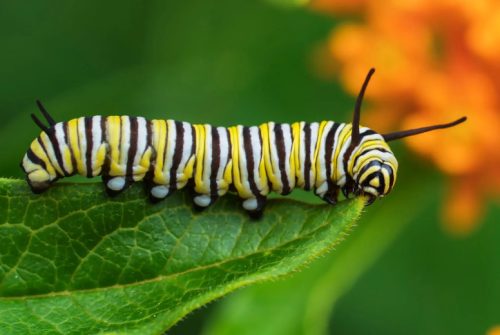
It is a striped caterpillar with black, yellow, and white markings. The white prolegs and two black tentacles are distinctive features for easy identification.
Monarch caterpillars feed on milkweed and can grow up to 4.5 cm long. Milkweed plants’ diet makes this black and yellow caterpillar poisonous.
Identification Features |
Black, yellow, and white stripes |
Host Plants |
Milkweed plants |
Scientific Name |
Danaus plexippus |
Six-Spot Burnet Caterpillar
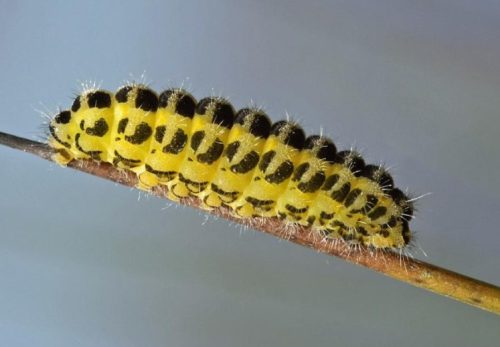
It is a fat yellow caterpillar with black horizontal stripes around its body. These caterpillars are native to the United Kingdom and can grow up to 2cm long.
The tufts of spiny hairs covering the pale-yellow body and black segments are the distinctive features. It turns into a black moth that is more active during the daytime.
Identification Features |
Black horizontal line patterns on a pale-yellow body. |
Host Plants |
Knapweed and thistle |
Scientific Name |
Zygaena filipendulae |
Yellow-Spotted Tussock Moth Caterpillar
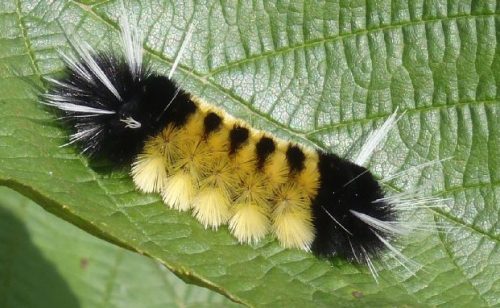
It is a fuzzy black and yellow caterpillar that resembles a giant bumblebee. The furry black ends and broad yellow bands around the middle segment are distinctive features.
The thin tufts of white hair are also noticeable from its ends and can give nasty stings when they rub on the skin. But yellow-spotted tussock caterpillars are non-venomous.
Identification Features |
Broad black yellow fuzzy bands and tufts of white hairs. |
Host Plants |
Birch, maple, oak, poplar, and willow |
Scientific Name |
Lophocampa maculata |
White-Marked Tussock Furry Horned Caterpillar
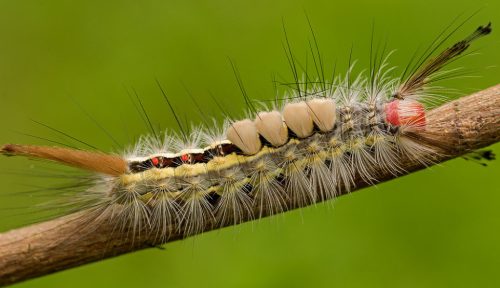
It is a furry yellow and black caterpillar that turns into a giant brown moth. The redhead and tufts of yellowish hairs are the distinctive features for easy recognition.
These caterpillars have long black spines that can cause skin irritation or allergic reactions among humans. They can grow up to 3.5 cm long.
Identification Features |
Yellowish-white stinging hairs, yellow stripes, and redhead |
Host Plants |
Birch, cherry, apple, oak, and even some coniferous trees |
Scientific Name |
Orgyia leucostigma |
People Who Read This Also Read:


